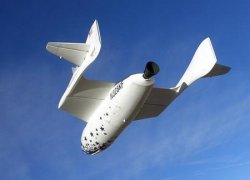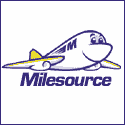
Monday, 22 November 2004, 13:20 CST
SpaceShipOne Named Time's 'Invention of the Year'
Associated Press

LOS ANGELES (AP) -- SpaceShipOne, the first privately financed manned rocket to fly into space, has been named Time magazine's "Invention of the Year" for reviving the dream of spaceflight for regular folks. The honor is announced in issues of Time hitting newsstands Monday.
The magazine in particular noted designer Burt Rutan's solution for overcoming the problem of intense heating that other types of spacecraft face when they plunge back into Earth's atmosphere at high speed.
SpaceShipOne was designed with its twin tail booms on hinges to allow the tail sections to fold upward at a right angle to the fuselage when the craft is at its apogee, or the top of its suborbital flight path.
Like the feathers of a badminton shuttlecock, the drag of the folded tail slows the re-entry to prevent the buildup of speed and heat. Later during the descent, the tail booms fold back into their normal position to allow the craft to fly as a glider and land on an airport runway. Rutan and his pilots call it a "carefree re-entry."
In contrast, NASA's space shuttles need a layer of thermal tiles and Russia's Soyuz spaceships use heat shields to protect against damage from fiery re-entry.
SpaceShipOne was funded by Microsoft co-founder Paul G. Allen at a cost of more than $20 million and was built in Mojave, Calif., at Rutan's company, Scaled Composites, located on Mojave Airport.
In June, pilot Mike Melvill was at the controls when the craft made its historic flight to an altitude of 62 miles, becoming the world's first private manned spaceship. The Federal Aviation Administration awarded him the first commercial astronaut wings.
The craft then was entered into competition for the $10 million Ansari X-Prize for the first private rocket ship to reach space twice within two weeks. Melvill flew back into space in September and colleague Brian Binnie took SpaceShipOne up again Oct. 4 to capture the prize.
On the Net:
Scaled Composites
Ansari X-Prize
The Associated Press contributed to this report.
Copyright © 2004 The Associated Press. All rights reserved. The information contained in the AP News report may not be published, broadcast, rewritten or redistributed without the prior written authority of The Associated Press.
AviationHistory.org shall not be liable for any errors or delays in the content, or for any actions taken in reliance thereon.
|
 |














